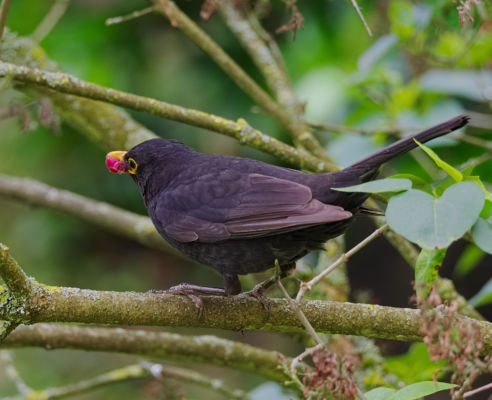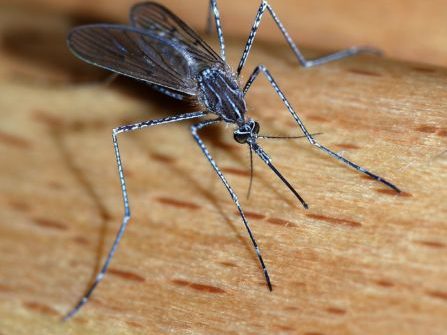We’ve got a pretty good idea of the damage being done to our native wildlife by introduced predators, but when it comes to introduced diseases, there has been little research done on the impact those diseases might be having. Take, for example, the parasitic disease avian malaria.
Like human malaria, avian malaria is a mosquito-borne disease and we know that captive and wild native NZ birds can get it. What we don’t yet know is whether introduced avian malaria strains result in a few sick native birds – or whether the disease is a significant contributor to the decline in native bird populations.

A group of Dunedin researchers – Chris Niebuhr and Robert Poulin from the University of Otago and Daniel Tompkin from Landcare Research, Dunedin – recently investigated patterns of infection at different elevations. Mosquitoes, which are vectors for the avian malaria, aren’t present at higher altitudes. The results of their study have been published in the open access online journal PLoS ONE.

“…a survey was conducted in Nelson Lakes National Park, a site experiencing native bird declines in which disease has been suggested as playing a role… Sampling was conducted along the St. Arnaud Range in NLNP. This area of the St. Arnaud Range is included within the Rotoiti Nature Recovery Project (RNRP), one of six mainland ecological restoration projects (‘mainland islands’) in New Zealand.”
“Sampling took place at four elevations (650, 800, 1200, and 1400 m), located above and below the reported bird decline threshold elevation of 1000 m. Birds were captured by mist netting between sunrise (0500 hr) and an hour before sunset (2100 hr) during the warmer months for three consecutive years, 2012–13 (March-April), 2013–14 (November-March), and 2014–15 (January-April). After swabbing with 70% ethanol, 50–100 μl of blood was collected by capillary tubes via brachial venipuncture with 27 gauge needles…”
Wildlife is particularly vulnerable to parasitic diseases that it hasn’t co-evolved with and it is thought that there are multiple strains of avian malaria present in New Zealand birds. Some malaria lineages have possibly evolved in New Zealand’s native bird species, but others have been introduced here along with introduced birds. Those introduced birds such as blackbirds and thrushes, which co-evolved with the malaria parasite, may have more resistance to it and may act as carriers and ‘disease reservoirs’.
“Avian malaria is a vector-borne disease caused by protozoan parasites of the genus Plasmodium… Infection by malaria parasites consists of two phases, acute and chronic. The acute stage occurs immediately after infection, followed by the chronic stage with some seasonal relapses. The acute phase is characterised by a high level of parasitemia and hosts can show clinical signs such as lethargy, reduced weight gain, and sometimes death. Individuals experiencing acute illness may have difficulty foraging or escaping predators. During the chronic phase, hosts experience a low level of parasitemia. These chronic infections can last for years, and can have a mild impact on individual fitness…”
Birds can and do die from avian malaria, including native New Zealand species.
“The presence of Plasmodium parasites has been confirmed in native New Zealand avifauna and has been linked to mortality in multiple species. Plasmodium parasites have also been confirmed in multiple non-native species in New Zealand, with the suggestion that some may be acting as reservoirs for spillover infection to native species. The exact number of Plasmodium lineages (defined by unique sequences of parasite mitochondrial cytochrome b DNA) in New Zealand is unclear, but as many as 17 have been reported, with four generally accepted non-native lineage clusters. Additional unresolved lineages have been reported, including some speculated to be native to New Zealand.”
The researchers collected a total of 436 blood samples over the three seasons, across the elevational range.
“Blood samples were collected and analysed from 436 individual birds representing 15 species from 11 families, with 369 samples collected from lower elevations (650 and 800m) and 67 samples from higher elevations (1200 and 1400m). More non-native birds were caught at lower than higher elevation, whereas numbers for native birds was similar between elevations. Plasmodium spp. was detected in a total of 26 blood samples from three of six non-native species, and two of nine native species.
Native birds are declining in the Nelson Lakes study area, as they are across New Zealand. Are predators solely to blame? The researchers hypothesise that disease may also be having an impact.
“Previous research conducted in Nelson Lakes National Park indicates a general decline in bird abundance during the last 30 years, with greater declines below an apparent elevation threshold of around 1000 m. The authors suggested this is due to predation, with greater pressure at low elevation. However, it could also be that malaria, as a mosquito-borne disease, is involved. Since mosquito densities are highly dependent on temperature, transmission rates also tend to be higher at low elevation.”
The blood samples revealed that avian malaria was more prevalent in non-native than native species – and particularly high in blackbirds and thrushes.
“Of the five bird species that were positive for malaria parasites, Eurasian blackbird (Turdus merula) and song thrush (T. philomelos) showed the highest overall parasite prevalence; 42% and 45% respectively. Parasite prevalence for house sparrow (Passer domesticus), South Island robin, and silvereye (Zosterops lateralis) was 5%, 13%, and 3%, respectively.”
“Based on data from the current study, we suggest that the Turdus spp. (especially the Eurasian blackbird) may be key reservoir hosts for malaria parasites in Nelson Lakes National Park. The blackbird is abundant throughout both the North and South Island and is a known reservoir of Plasmodium parasites in other countries, specifically implicated as a key reservoir host. In this study, both the blackbird and song thrush showed a significantly higher prevalence than any other species, and were caught in all habitat types at all elevations. Turdus spp. individuals move frequently between habitat types during the breeding season and can penetrate deep into New Zealand forests, while most other non-native bird species do not.”
The malaria parasite was less prevalent in native bird species than in introduced birds – so is that good news? Not necessarily. If the disease affects native birds more acutely, it is possible that fewer survive infection and the associated impact that acute illness has on increased predation risk – and therefore fewer are detected alive, with the disease.
“…an overall higher prevalence in non-native (14.1%) versus native birds (1.7%) may indicate differential impacts on these two groups, while particularly high prevalence in non-native Turdus spp. [blackbirds, thrushes] supports previous suggestions that they are key reservoir hosts for the disease…”
“Of note, no parasite was detected in the five native bird species undergoing decline in NLNP over the past 30 years, yet a high prevalence was observed in blackbirds, a species not reported as declining. We suggest that despite reports of low malaria prevalence in native hosts, transmission may still be occurring, however with lower detection due to potential impacts of infection. Our findings provide further support to the hypothesis that disease, in addition to predation and competition, could be playing a role in observed population declines at this site.”
And then there’s climate change – what might happen if warming global temperatures increase the altitudes at which mosquito disease-vectors are found…
“Since both the malaria parasite and reservoir host have been detected at elevations as high as the tree line, the presence of a competent mosquito vector may be the only missing component of the malaria transmission cycle at these higher elevations. This may have important implications for species or populations occurring in greater numbers at higher elevations such as the brown creeper (Mohoua novaeseelandiae), due to the threat of climate change and with it the potential upward elevational movement by mosquitoes.”
This research is preliminary – it doesn’t determine what impact avian malaria is having. What it does do is show that there is a lot still to be learned and a number of important questions for which we don’t currently have answers. To date, some of those questions haven’t even been asked.
“We argue that one of the greatest knowledge gaps regarding avian malaria in New Zealand is the lack of information on host susceptibility to infection, information that could be obtained through experimental infection studies. If the native avifauna is impacted by avian malaria at a population scale, and a differential impact on host species is occurring due to specific Plasmodium lineages, it would carry with it a whole new complexity to the conservation of native wildlife in New Zealand. Supporting evidence for such disease impacts will enable appropriate management to be developed and put in place, while a lack of evidence will enable resources to remain focused on the other issues facing New Zealand’s native species (e.g. through habitat restoration, pest control, translocations and genetic management). In the case of the former, providing managers with more specific information of any potential disease impacts on native bird populations could help avoid costly or less efficient “blanket” conservation and management efforts.”
The full research report is freely available online through open access publication by PLoS ONE.

